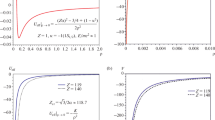Abstract
A static version of the composite model of fermions is considered. A second variational principle is introduced which leads to a nonclassical Lagrange problem and selects out states with definite energy. The solution of this problem gives both a) the interaction strengths and b) the ground states of the various classes of fermions as functions of the radii of the strong interactions. A relationship is found between the energy of the system of fields and the set of invariants of the general Lorentz group. This relationship can be used as a basis of classification of the fermions; it leads to a new concept about the possible origin of the baryon and lepton charges. The problem is solved by direct methods in a space of singular spinors; this condition is not essential.
Similar content being viewed by others
References
V. B. Berestetskii, UFN,85, 393, 1965.
“The nature of materials,” UFN,86, 591–719, 1965.
Y. Nambu and Jona-Lasinio, Phys. Rev.,122, 345, 1961;124, 246, 1961.
H. Katsumori, Progr. Theor. Phys.,31, 642, 1964.
Yu. M. Loskutov and L. de la Pen'ya Auerbakh, Izv. vuzov SSSR, Fizika, no. 6, 1964.
A. M. Naumov, Izv. VUZ. Fizika [Soviet Physics Journal], no. 5, 1965.
H. Dürr and W. Heisenberg, Nuovo Cim.,37, 1446, 1965.
G. Doolen, T. Kanki, and A. Tubis, Phys. Rev.,B142, 1072, 1966.
D. Ivanenko, Phys. Zs. Sowjetunion,13, 141, 1938.
R. Finkelstein, R. Lelevier, and M. Ruderman, Phys. Rev.,83, 326, 1951; R. Finkelstein, C. Fronsdal, and P. Kaus, Phys. Rev.,103, 1571, 1956.
A. A. Borgardt, ZhETF,33, 59, 1957; Nuovo Cim.,5, 102, 1957.
V. Glasko, F. Leryust, Ya. Terletskii, and S. Shushurin, ZhETF,35, 424, 1958; D.P. Terletskii, DAN SSSR,193, 508, 1960.
D. Ivanenko and D. F. Kurdgelaidze, ZhETF,44, 587, 1963; Izv. vuzov SSSR, Fizika, no. 3, 1963.
D. F. Kurdgelaidze, Izv. vuzov SSSR, Fizika, no. 4, 1964; no. 3, 1966.
M. A. Lavrent'ev and L. A. Lyusternik, A Course in Variational Calculus [in Russian], 1950.
L. S. Pontryagin, et al., Mathematical Theory of Optimal Processes [in Russian], FI, 1961.
L. B. Okun, ZhETF,47, 1777, 1964.
L. V. Kantorovich and V. M. Krylov, Approximate Methods of Higher Analysis [in Russian], FM, 1962.
L. E. Lebedev, Izv. vuzov SSSR, Fizika, no. 1, 1964.
L. E. Lebedev, Izv. vuzov SSSR, Fizika, no. 4, 1964.
Author information
Authors and Affiliations
Additional information
The author wishes to express his deep gratitude to Prof. D. Ivanenko, G. A. Sokolik, Prof. Ya. P. Terletskii, and the participants in the seminars at the Moscow State University for their discussions of this work and valuable comments, and to A. A. Borgardt, V. S. Vanyashin, and V. I. Mal1 chenko for numerous useful discussions and advice.
Rights and permissions
About this article
Cite this article
Lebedev, L.E. The optimal lagrange problem in the composite model of elementary particles. Soviet Physics Journal 10, 57–60 (1967). https://doi.org/10.1007/BF00819796
Revised:
Issue Date:
DOI: https://doi.org/10.1007/BF00819796



